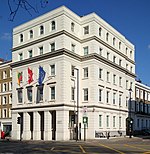Morpeth Arms
Grade II listed pubs in the City of WestminsterPimlicoPub stubs

The Morpeth Arms is a public house at 58 Millbank, in the Pimlico district of London. It was built in 1845 to refresh prison warders serving at the Millbank Penitentiary.It now contains a Spying Room which provides a good view of the headquarters of the Secret Intelligence Service MI6 across the river Thames. The building is listed as Grade II and it is now part of the Young's estate.
Excerpt from the Wikipedia article Morpeth Arms (License: CC BY-SA 3.0, Authors, Images).Morpeth Arms
Millbank, London Millbank
Geographical coordinates (GPS) Address Website External links Nearby Places Show on map
Geographical coordinates (GPS)
| Latitude | Longitude |
|---|---|
| N 51.48937 ° | E -0.12866 ° |
Address
Morpeth Arms
Millbank 58
SW1P 4RW London, Millbank
England, United Kingdom
Open on Google Maps








